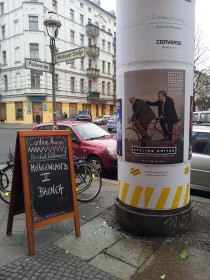Pessach is approaching – the festival of exodus and freedom. This year, there is less talk of having the festive meal at large community gatherings. It is obvious, although unspoken, that smaller gatherings in the home make more sense. We are becoming alienated from our community centers through fear. Keep a low profile. Don’t speak Hebrew on the streets. Some people are removing the mezuzah from their front doorposts, a traditional object that visibly identifies a Jewish household. There is a mood of caution and nervous apprehension.
How did it get to this point?

Advertisement with Imam Ferid Heider and Rabbi Daniel Alter for the “Cycling Unites”-Critical-Mass-Tour in Berlin on 22 March 2015, photo: Michal Friedlander
June, 2014
A drunken man rolls slowly off the train platform and plops onto the tracks at Friedrichstrasse station. Around sixty people witness the moment and look away, hoping that someone else will solve the stinky, awkward problem. And so it was. An Italian and an Israeli jumped down to haul the semi-conscious man to safety. The passengers walked around the startled little group, pressing forward to make the oncoming train.
July 2014
Dinner party small talk. The discussions nearest me are taking a more political turn and I am just not in the mood to talk about Israel. Too late. The young man next to me asks if I saw the recent pro-Palestinian demonstration on the Kurfürstendamm? He becomes very still and lowers his voice. “I was there,“ he says quietly. “I was taking a stroll with my grandmother on my arm. My grandmother who survived Auschwitz, my grandmother who has a tattoo on her arm had to hear the shouts: ‘Jude, Jude, feiges Schwein – komm heraus und kämpf’ allein.’ Where are we? Is this Berlin, 2014?”
September 2014
A call to the Jews of Germany! We are marching! We say no to anti-Semitism and demand mutual respect for all cultures and beliefs! We will march arm in arm to the Brandenburg Gate – tolerant brothers and sisters from all cultures! We will show the world a thing or two about human dignity!
It wasn’t quite like that. We were moved to hear the German President and Chancellor, the Mayor of Berlin and an eloquent church representative champion a democratic and liberal society. But someone was missing. Yes, there were Jews who had driven up from Munich at the crack of dawn; there were organized church groups and even a smattering of Copts. The organizers estimated that there were around 8,000 attendees, but even if you included every armed police official, you would have been hard pressed to count 4,000 people. Max Mustermann (John Q. Public) was busy that Sunday afternoon.

Poster for the demonstration against anti-Semitism on 14 September 2014 in Berlin, photo: Michal Friedlander
November 2014
I attend a Jewish Museum conference in Warsaw. It opens with three minutes of silence in memory of those killed in the May terror attack on the Jewish Museum in Belgium. The time passes quickly and we move on.
January 2015
The horrific and murderous hand of religious fanaticism is even more tangible. 17 people died in Paris after three days of deadly attacks, one at the offices of a satirical magazine “Charlie Hebdo” and another at a kosher supermarket in the capital. 40 world leaders lead a march of unity from the Place de la Republique, followed by 1.6 million people crying “Je suis Charlie!”
Would so many people have taken to the streets of France because of the attack on the kosher supermarket, or for a comparable attack on a mosque or homeless shelter?
February 2015
Attacks in Copenhagen. In our museum offices, non-Jewish colleagues are receiving worried telephone calls from relatives who are concerned for their safety.
I get a call from Brussels. Could I recommend a place in the States where it might be possible to raise Jewish children with a positive Jewish identity; a place where a family can live openly as Jews without feeling under threat? We have the same heated discussion that our grandparents had in 1935. Where is the safest place for Jews to live in Europe? Is moving to Israel a viable or relevant option?
Dr. Josef Schuster, President of the Central Council of Jews in Germany, warns against wearing a kippah, a traditional Jewish head covering, in certain urban neighborhoods. No “visible” Jew needs to be told this, but knows from depressing experience that when taking the air, it is wise to conceal a kippah under a generic hat. Schuster is trying to send a signal to the general population, but the point goes over their heads, so to speak.
March 2015
Back to my routine commute on the U-Bahn – the inner city forum for human and viral encounter. A woman enters my compartment and yells at a man who may, or may not be Moslem, “Go back to where you came from! We don’t want your dictatorship here!” Another passenger responds, “Your problem is with the media, not with us. Leave us alone.” “You see,” she shouts back, “I can’t even express myself for two minutes on the train!”
After making the school run, we pass a newsagent’s shop that brandishes the news headline “192 attacks on Jews.” I want to keep walking but am transfixed. “I wish that I weren’t the only Jewish person in my class” my young daughter remarks, “and I wish that it could be a boy. If there were two Jewish girls in the class, the boys would laugh at us.”
Freedom. The freedom to express hatred and the freedom to ignore it. And you and me are free to be you and me.
Michal Friedlander, Curator for Judaica and Applied Arts